Scuba Tours Worldwide are running two 12 day ‘Shark Specials’ aboard MV Sea Spirit which will take in the shark-diving highlights from SEVEN of the beautiful Maldivian atolls. These are exciting, challenging safaris with a route that includes sites which are very rarely dived.
The first trip starts in Male atoll with divers joining MV Sea Spirit near the international airport and then travelling south to Cocoa Channel in South Male Atoll, the infamous Alimathaa nurse shark night dive plus the excellent shark channels of Miyaru Kandu in Felidhoo Atoll and Shark Channel in Meemu Atoll where we have regularly seen silvertips amongst the schools of grey sharks. We will also dive at Kurali and Vattaru where mantas are sometimes seen. We then cross into Thaa Atoll and onwards to Laamu Atoll. The latter is famous for the north east channels where large numbers of grey sharks are frequently seen at this time of year. There is an ocean crossing down to Huvadhoo giving us the chance to dive the eastern channels of this atoll where large numbers of sharks are commonly seen. We expect to see grey sharks in large numbers, white and black tip reef sharks, silvertip sharks, tawny nurse sharks and zebra sharks. We will look for whale sharks – although sightings are variable at this time of year. With luck, we should see scalloped hammerhead sharks and we might be lucky and see the less common pelagic species. Many species of ray are also common at these sites and we expect to see round ribbontail rays, pink whiprays, Jenkin’s whiprays, feathertail rays, manta rays and maybe porcupine rays. Beyond Felidhoo Atoll there are few resorts and few liveaboards, giving these trips a “remote” feel. From Huvadhoo atoll, returning divers will then take a domestic flight back to Male. The return trip, starting in Huvadhoo, will make the reverse itinerary.
Most of the diving is made in channels and would suit adventurous divers who are used to current or who are up to learning how to dive in current: it’s all about technique! We will be making drift dives as we don’t like swimming into current either, so we drop and make our dive descent up-current, drift to where the action is, and then drift onwards. As a high proportion of the dive is spent in the 25-30m range, the use of nitrox is highly recommended (the course can be completed on-board for unqualified divers who would like to use nitrox).
Trip dates: 25th Jan to 6th Feb and 8th to 20th March 2015.
Cost: £2,361pp plus international flights (which Scuba Tours Worldwide can organise from your local UK airport).
Details: For more details go to www.scubascuba.com or contact our Sales Team on 01284 748010







